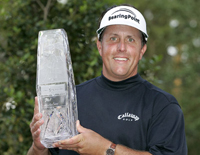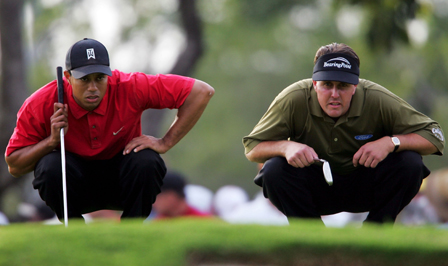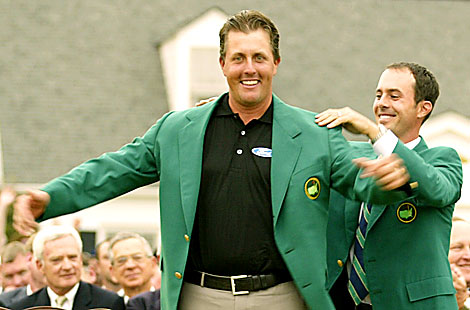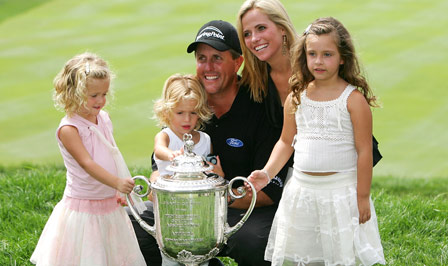 As I read my last Thrash Talk it occured to me that maybe it would be interesting to focus on the historical standing of a player other than Tiger Woods… or Jack Nicklaus, or Arnold Palmer, or Ben Hogan. It is a common theme in all sports to view the retired generations of stars as the gold standard of excellence, their career achievements standing like monuments on the top of a hill. Monuments which remind us of the great moments, ignoring the failures along the way.
As I read my last Thrash Talk it occured to me that maybe it would be interesting to focus on the historical standing of a player other than Tiger Woods… or Jack Nicklaus, or Arnold Palmer, or Ben Hogan. It is a common theme in all sports to view the retired generations of stars as the gold standard of excellence, their career achievements standing like monuments on the top of a hill. Monuments which remind us of the great moments, ignoring the failures along the way.
Active players, in contrast, have incomplete careers, and generally no monuments. We are far better acquainted with both their successes and their failures, often causing us to rank them below the illusory image of the flawless champ of yesteryear. Certainly this is not true of all players; anyone watching Tiger Woods, or Roger Federer, or Michael Phelps, cannot escape the historical significance of their achievements, even in young, incomplete careers. But what about Tiger’s top competition? Could Tiger’s domination lead us to perhaps miss something truly great, right under our noses?
A Familiar Name
So (in my best Rod Serling) I ask the reader to consider, if you will, a man, a golfer, a California-bred magician with the lob wedge. He’s been called everything from a Wizard to a choker to “FIGJAM” (Google it if you don’t know what that means), but for my money, Phil Mickelson is a better golfer than any of us currently realize, a no-doubt-about-it member of the all-time greats.
 Time sort of stopped when Tiger won the ’97 Masters; things were never the same. Years later, it’s almost as if nothing at all happened in golf between Nicklaus in ’86 at Augusta and Tiger in 1997. Among the fallout from this period of amnesia is much of the memory of Mickelson’s amateur career. Remember that Phil Mickelson had one of the most successful junior and amateur records in golf history, and at the time he turned pro there was a general sense of excitement about the potential for a hall-of-fame career. He won consecutive NCAA Titles, was one of only two golfers in history to hold both the NCAA and U.S. Amateur titles at the same time.
Time sort of stopped when Tiger won the ’97 Masters; things were never the same. Years later, it’s almost as if nothing at all happened in golf between Nicklaus in ’86 at Augusta and Tiger in 1997. Among the fallout from this period of amnesia is much of the memory of Mickelson’s amateur career. Remember that Phil Mickelson had one of the most successful junior and amateur records in golf history, and at the time he turned pro there was a general sense of excitement about the potential for a hall-of-fame career. He won consecutive NCAA Titles, was one of only two golfers in history to hold both the NCAA and U.S. Amateur titles at the same time.
Lefty won a PGA Tour event (the Northern Telecom Open) before turning pro, as a 20 year old at Arizona State, birdieing the final hole pull it off and defeat veteran Tom Purtzer. Tiger never won a pro event as an amateur golfer. Nor did Jack, Arnie, or Ben, for that matter.
Bad Timing
In many respects, Phil’s timing has been his worst enemy. Not his swing timing, or his putting tempo, or his comedic sense. What I’m talking about is that Phil Mickelson was at the point in his career when most golfers begin to take off when the greatest player in history arrived on the scene. I guess we don’t know for a fact that Phil would have won more tournaments or majors if Earl and Tida had never hooked up, but come on, do you really think that of Tiger’s 64 PGA Tour wins and 13 majors in the last 11 years, Phil wouldn’t have won at least a few of them?

The career trajectory of athletes is a topic unto itself, but one thing we see frequently is that the greatest of all players usually begin winning and beating the world at a very young age. Not always, of course, but in general superstars tend to start out as young phenoms. It’s important to remember, however, that this is not absolute or even the norm for all players. In golf in particular, most require a few years of seasoning, and there have been some tremendous champions who did not lead the race wire to wire. Hogan is the prototype of this late-bloomer trajectory, and Tom Watson is a comparable, more contemporary example.
Watson debuted on tour in 1971 and won his first major (The Open Championship) in 1975. He was, as was Phil, quite successful in regular tour events in his early years, but faltered down the stretch in a major or two, prompting some to wonder, early on anyway, if Watson really had the stuff to be a champion. The question was answered with a string of major victories and a dethroning of Jack as the world’s best in the mid- to late 1970s.
Mickelson, of course, took a little longer to finally win a big one and fulfill the promise of the Northern Telecom win, and while his record in Tour events is comparable or better than Watson’s, he certainly has some work to do to catch Watson in the major championship department. But there’s a critical difference between the two men: competitive context.
By 1975, Nicklaus, although still a great player and a force in majors, was definitely in the decline phase of his great career. He had by this time become significantly involved in various business ventures, had a maturing family, and, as he stated in his autobiography, had some degree of decline in both his skills and his focus and motivation towards winning. He was still Nicklaus, yes, but not the same man as the young Nicklaus, or anything resembling the young Tiger Woods.
Seve Ballesteros was the closest thing Watson had to a superstar in his prime as a competitor, but Seve played more in Europe and was, for all his greatness, not as consistent a performer in the US, nor was he the same caliber player in the U.S. Open or PGA as other great champions. For the most part, Watson enjoyed an 8-10 year period without a serious pretender to his throne.
In 1997, Phil’s five-year point, Tiger came on the scene. Ouch.
We can debate Tiger versus Jack versus Arnold, et al forever, but one thing I’m sure of is that no player competing against Tom Watson between 1975 and 1985 was even close to as good as Tiger Woods was between 1997 and 2008.
 Yet even in the face of Tiger’s domination, and with Vijay Singh winning over 30 tour events, and with a seemingly bottomless talent pool on the modern PGA Tour capable of winning, Mickelson has won 32 Tour events and three major championships.
Yet even in the face of Tiger’s domination, and with Vijay Singh winning over 30 tour events, and with a seemingly bottomless talent pool on the modern PGA Tour capable of winning, Mickelson has won 32 Tour events and three major championships.
As of this writing, Phil has played in 371 PGA Tour events, and has made the cut 303 times, or 82%. Tiger is rightfully lauded for his streak of made cuts, so Phil deserves props here, too. Phil has 133 top tens (36%). While not quite in the same stratosphere as Tiger, Phil’s stats in these areas tell a story of sustained, high level play.
Think about that for a minute: someone not named Woods has, over a sixteen year stretch, finished in the top ten in over a third of the professional events he’s entered. You don’t amass this sort of record by being stupid, or reckless, or not practicing hard and managing your game well.
In fact, this is the part of Phil’s “rap sheet” that incenses me more than anything else. He is routinely criticized for taking too many chances, for squandering opportunities, and for letting the big one get away. Announcers and ex-touring pro golfers with records far inferior to Mickelson’s paint a picture of him which borders on golf dunce.
But I think it’s important to realize that those failures, often one-hole or one-shot situations where he failed tragically and dramatically (short putts in the Pinehurst and Shinnecock Opens, the eighteenth at Winged Foot), are not exclusive to Mickelson, and do not erase his high level of performance in other areas. And I am certain that if we could rewind the tape on every great champion out there, we can find instances of choking, bad decisions, and failed execution.
No, I’m not trying to apologize for Phil botching Winged Foot, or to say that Nicklaus choked just as often. There is without at doubt a distance between Phil and many of the other all-time greats. My point is that the distance is closer to a stream than an ocean. And Phil still has time to close the gap.
I have often heard people point out “you know, Jack Nicklaus was so great, he finished second almost as often as he won the majors!” It’s usually used to punctuate Jack’s greatness – in other words, when he didn’t win, he was often in second place.
If Jack deserves positive credit for this, isn’t at least a little unfair that other players often get beaten up for finishing second? Phil has had a sustained record of excellence in the U.S. Open over the last eight years or so, coming close on multiple occasions. Maybe he didn’t get as much out of his opportunities as he could have, but the record is nonetheless evidence of excellence, not failure. We need to remind ourselves every so often that there are precious few golfers good enough to finish multiple U.S. Opens, let alone finish in the top ten multiple times.

Lefty is 37 years old, and should have at a minimum five more years where he is one of the dominant players in the world; I would expect him to win as many as 10-12 events in that time, with perhaps another major or two. If so, Mickelson would have a career record better than many fine players, including Miller, Trevino, and Irwin. When you consider the competitive context of Mickelson’s career, I don’t think it’s at all unreasonable to put such a record (40-plus tour wins, five majors) in the same class as Watson, Player, and Nelson.
I read something several years ago (before Phil had won a major) in which Jack Nicklaus was quoted as saying “Phil Mickelson is a nice player, but he’s not what I consider a great champion.” Kind of hard to argue with Jack on the definition of a champ, I know, but all I can say is don’t just automatically buy everything you hear people say about Phil Mickelson.
Judge him objectively, and I think you’ll find he is a tremendous athlete, not only in his flashy short game talent and booming drives, but as evidenced by an extremely consistent, high level of performance during what is arguably the most competitive era of golf history. While Tiger’s status as the greatest will never be threatened by Phil Mickelson, there have been few players in the history of the game who could have gotten as close.
Photo Credits: © PGATour.com, © Getty Images, © CNN.com, © PGA.com.

I believe your article highlights the risk comparing players in differnt eras. The most anyone can do is hope to be the best of their own era. Comparing golfers from different eras is unfair to both. Bobby Jones who played sparingly against a much different level of competition, while working full time, playing with Hickory on what today would considred goat track conditions, to players with different training opprotunities, video, launch monitors, different balls, equipment etc., is completely unfair to both. Your appreciatiation for a player in proper context is a breath of fresh air.
I wouldn’t want to argue with Jack, either, and I won’t, except to say that just based on the numbers, Phil is in some pretty rarified company. He has taken a lot of criticism in the past few years, some deserved ( Winged Foot ), some not. I also think it is just fair to point out that it has been Phil’s unfortunate fate to have a career contiguous with one who may arguably be the best to ever play the game.
JP, you have properly put into some good context the very fine accomplishments of an outstanding golfer. Excellent article.
“do you really think that of Tiger’s 64 PGA Tour wins and 13 majors in the last 11 years, Phil wouldn’t have won at least a few of them?”
Interesting article, and well written. I wonder in how many of Tiger’s victories has Phil finished second or even within the top 5 (as we know Tiger’s ability to effect how others play)? Any statistics on that?
Great article. I am not a big Phil fan but you point out some valid points. It makes me think differently about Phil. It is also very refreshing not read another article on Tiger’s dominance in the game.
I think that any player that rises to the level of pro provides all of us some valuable tips and lessons. I agree, it’s too bad they get overlooked because they can provide good insight to the game if someone spends the time to learn from them.
Yeah, this was a great article, and it needs to be said: Phil has put together an amazing career. I don’t like him much, but MAN what a golfer!
When you think about it, there’s only 9 spots available in the Top 10 because one of the spots is always reserved, so his overall record is even more impressive. But he’s still an unappealing guy.
I think the Winged foot fiasco significantly altered Phil’s bid for greatness. Fresh of a PGA and Masters win, it would be hard to argue that a third straight major win would not have been something ‘great’ besides Tiger’s 2000 in the modern era.
Had he won there it possibly would have been the most serious attack on Tiger’s throne ever since he broke out in 1997 and possibly the greatness he has been flirting with.
Seems like Phil simply lost traction after that and has been pedalling pretty hard to get back to the same level. But for some unknown X factor he simply can’t get back there. I don’t think that he is a head case like Ernie at all.
It would definitely make elite golf more interesting if Tiger had to keep a more careful eye on the rear view mirror.
Phil is one of the great ambassadors of the game. I know you can’t argue with Jack, but in this case I would.
Absolutely excellent article.
A very well written piece.
Unquestionably, Mickelson is one of golf’s greatest talents. I’m not a big fan of his, but you have to respect his abilities and his record. He certainly merits inclusion in the Pantheon of golf greats.
Phil was one of the few contemporaries who could match Tiger in the raw talent stakes.
What is frustrating is that Phil does not appear to have fancied the hard grind practiced by Woods in the physical and mental conditioning stakes.
I feel sorry for Phil. He is rich, plays a wonderful game of golf, has a beautiful family and flys his jet home everynight when he plays on the west coast, puts his slippers on and has a cool one in Rancho Santa Fe. Truly he is a great player, talent has never been a question, as for timing you may be on to something there. But there is something else, something special that Tiger has. In describing that something “special” the late-Great Jim Murray of the Los Angeles Times once wrote about Jack Nicklaus’ comtemporaries in much the same way. They were great golfers but it was their misfortune to be playing in the same era as Jack Nicklaus. But, he added, though they were talented and “great” in their own right, they were at an additional disadvantage against Jack because Jack had an “extra iron” in his bag: “Iron Will.” I think it is the same “extra” advantage Tiger has over other golfers who have the “mis” fortune of living in his era.